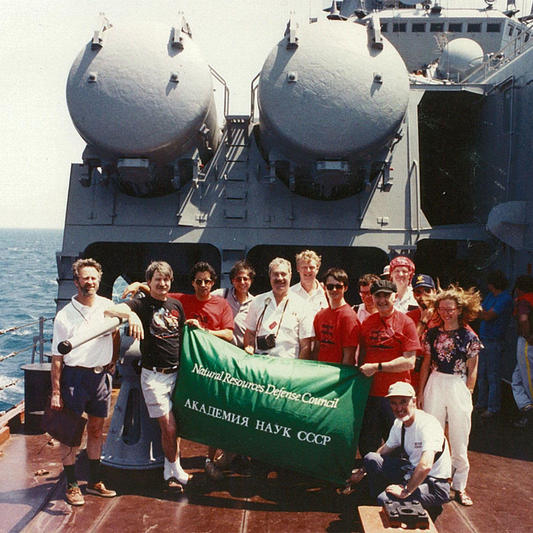 Science & Global Security is marking its 30th year of publication. To record this achievement, we include in this issue "Science & Global Security: 30 Years On, Still a Big Mission" (free PDF) a brief reflection on this long history by Harold Feiveson, the Founding Editor (1989-2010) and now Editor Emeritus, and Frank N. von Hippel, the founding co-chair of the Board of Editors. They explain what the journal has contributed and can still contribute to advancing technical analysis and policy for international peace and security.
Science & Global Security is marking its 30th year of publication. To record this achievement, we include in this issue "Science & Global Security: 30 Years On, Still a Big Mission" (free PDF) a brief reflection on this long history by Harold Feiveson, the Founding Editor (1989-2010) and now Editor Emeritus, and Frank N. von Hippel, the founding co-chair of the Board of Editors. They explain what the journal has contributed and can still contribute to advancing technical analysis and policy for international peace and security.
The three research articles in this issue show the diversity of topics that can benefit from independent technical analysis to inform policy debates on improving global security especially about current nuclear weapon threats and dangers. The articles cover the potential size of North Korea's nuclear weapons arsenal, the effort to interdict smuggling of nuclear weapons, weapon materials and radioactive materials, and the unenviable challenge faced by Britain of disposing of the world's largest stockpile of separated civilian plutonium.
In the first article, "Analysis of the DPRK's Nuclear Weapons Capabilities by Estimating its Highly Enriched Uranium Stockpile and Natural Uranium Reserves", Sherzod Kurbanbekov, Seung Min Woo and Sunil Chirayath offer a new assessment to constrain assumptions about how large North Korea's nuclear arsenal may be by looking at uranium resources and centrifuge enrichment capabilities. They use open sources, including interesting data from uranium exploration surveys in North Korea from 1947 to 1950 by the Soviet Union suggesting North Korean uranium reserves may be significantly larger than in other estimates. They conclude that "given the range of the estimates of DPRK's natural uranium ore reserves, its nuclear weapons program is unlikely to be constrained by uranium resources, provided they have the required mining and milling capacities."
"Analysis of the Frequency and Detectability of Objects Resembling Nuclear/Radiological Threats in Commercial Cargo" is the second article in this issue. Here, Brian Henderson proposes that cargo container gamma-ray radiography may be a feasible way to improve the likelihood of identifying nuclear weapons, weapon materials and radioactive material potentially being smuggled into the United States in one of the 50,000 standard cargo containers entering the country's ports each day. The article offers an analysis that looks for "large, dense regions" that could be a signature of either nuclear weapons or shielded weapon material using as a sample data set 122,500 radiography images produced by scanning containers on rail cars entering a European port. This signature was developed using a model of the radiography system and container and models of objects of interest for detection and interdiction, including a simplified nuclear weapon assembly first published in this journal in 1990 in the article "Detecting Nuclear Warheads," by Steve Fetter, Valery A. Frolov, Marvin Miller, Robert Mozley, Oleg F. Prilutsky, Stanislav N. Rodionov, and Roald Z. Sagdeev. The new analysis suggests that while a combination of gamma radiography and passive monitoring may enhance detection capabilities, it is unlikely to satisfy current detection goals.
The third article is "Assessing the PRISM Reactor as a Disposition Option for the British Plutonium Stockpile". Christopher Fichtlscherer, Friederike Frieß and Moritz Kütt assess Britain's consideration of the General Electric-Hitachi PRISM sodium-cooled fast reactor as means to irradiate as fuel and so dispose of its 110 tons of civilian plutonium as a nonproliferation measure, and whether this disposition could be done within 20 years as the reactor vendors claim. Their analysis models Britain's plutonium stockpile that would need to be irradiated as fuel, the PRISM reactor and its burnup, and the isotopic composition and radiation barrier of resulting PRISM spent fuel. The article finds that it would take over 30 years for two 840 MWth PRISM cores to irradiate the plutonium stockpile to a desired proliferation resistance radiation barrier equivalent to one Sievert per hour at one meter from the fuel. However, by the time all the plutonium has been irradiated, a fraction of the earlier PRISM spent fuel would no longer meet this proliferation resistance standard.
(Photo from the 1989 U.S.-Soviet Black Sea experiment. Credit: Thomas Cochran and Chris Paine, NRDC)
